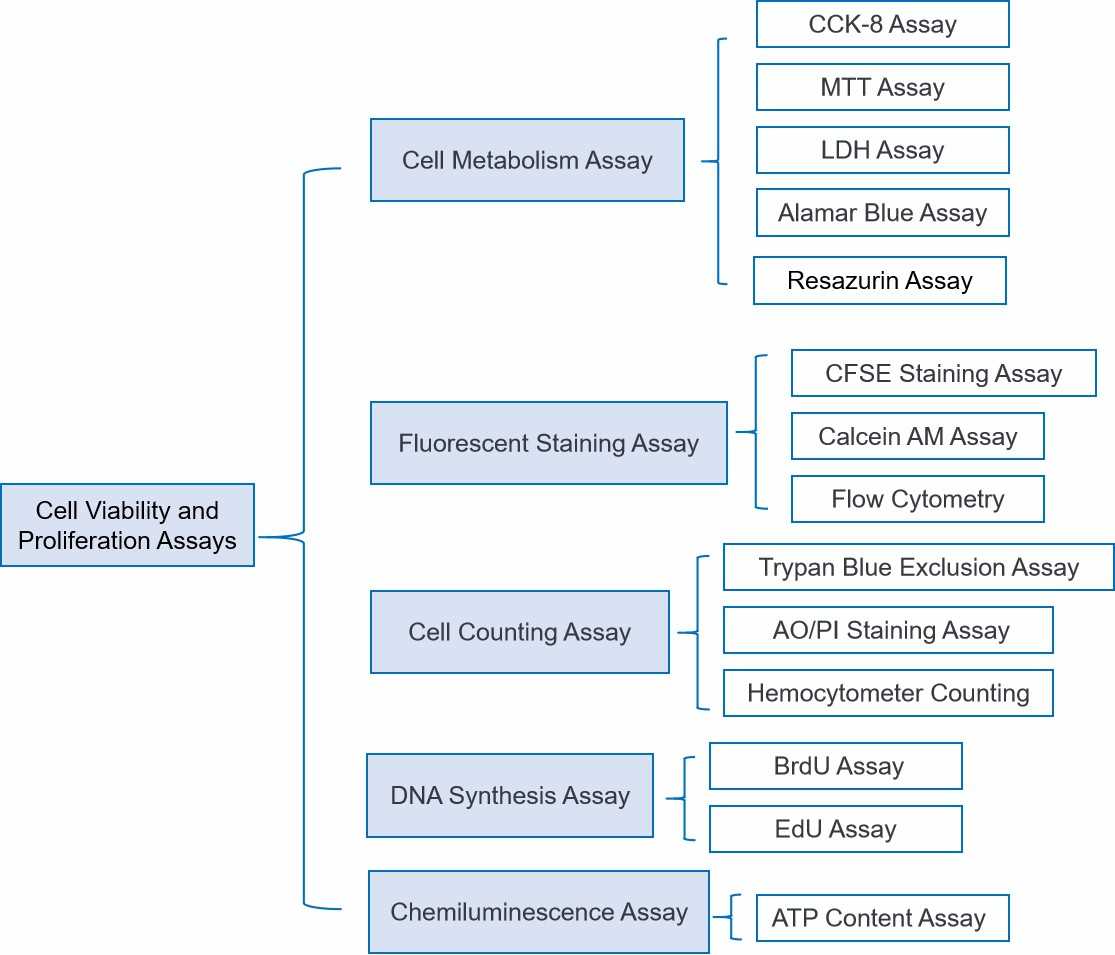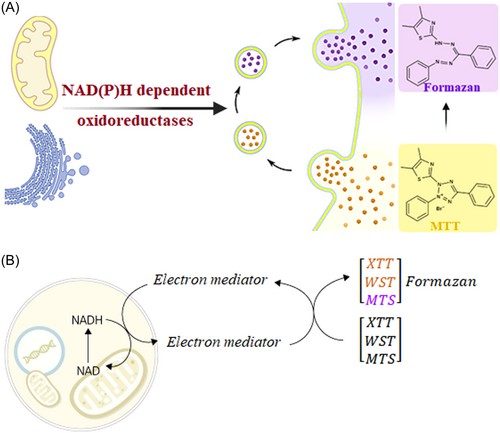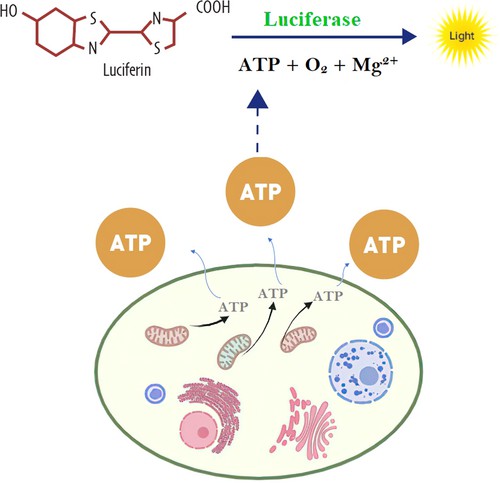Cell Viability, Proliferation and Cytotoxicity Assays
Cell proliferation means that cells product new cells by mitosis or meiosis. This is the core basis for organismal growth, development, reproduction and inheritance, and one of the primary determinants of how most diseases manifest and evolve. Cell viability reflects the proportion of healthy living cells in a cell population. Cytotoxicity testing assesses the impact of chemical substances or environmental factors on cell survival, that is, whether they cause damage or death to cells. Therefore, methods commonly used to detect cell viability and proliferation are also employed to assess cytotoxicity.

Fluorescent Dye Detection
- CFSE Assay: CFSE (Carboxyfluorescein diacetate succinimidyl ester) is a fluorescent dye that detects cell division and proliferation. It binds to the cell membrane, reacts with intracellular esterases to form a stable fluorescent protein, and decreases in fluorescence intensity over time as cells divide.
- Calcein AM: Calcein AM is a cell viability probe. It enters the cell membrane and is cleaved by intracellular esterases into Calcein, which flashes fluorescently in living cells. This is a low-toxicity, high-sensitivity way of testing cell viability.
- Flow cytometry provides a fast and reliable approach to measure cell viability; it can be used to determine the proliferation, viability and percentage of cells in various phases of the cell cycle all at the same time. This technique is used to monitor the dynamics of the cell cycle and its health, and is commonly combined with other dyes to detect cell activity and apoptosis.
Cellular Metabolism Assays
- MTT Assay: This is a traditional method used in the field of drug screening to detect cell viability and toxicity. Succinate dehydrogenase in living cells' mitochondria converts the exogenous MTT into insoluble blue-purple formazan crystals that collect in the cells.
- XTT Assay: The XTT (2,3-bis(2-methoxy-4-nitro-5-sulfophenyl)−5-[(phenylamino)carbonyl]−2H-tetrazolium hydroxide) assay is a commonly used method in real-time cell viability and proliferation studies. XTT can be reduced by mitochondrial NADH enzymes to form a water-soluble formazan crystal. Unlike MTT, it carries a net negative charge and essentially cannot penetrate cells, thus allowing it to be reduced on the cell surface or plasma membrane through electron transfer.
- WST Assay: WST-8 is the compound like MTT. It gets reduced by some mitochondrial dehydrogenases into an orange formazan by presence of an electron-coupling reagent. The darker the color, the more cell proliferative and toxic.
- MTS assay: MTS (3-(4,5-dimethylthiazol-2-yl)−5-(3-carboxymethoxyphenyl)−2-(4-sulfophenyl)−2H-tetrazolium) can be reduced by mitochondrial reductase to form a water-soluble formazan crystal, which is measured spectrophotometrically at 490-500 nm.
 Fig. 1. Tetrazolium salts assays (Khalef L, Lydia R, et al., 2024).
Fig. 1. Tetrazolium salts assays (Khalef L, Lydia R, et al., 2024).
- LDH Assay: Lactate dehydrogenase (LDH) is a commonly used cytotoxicity assay. By detecting lactate dehydrogenase released upon cell disruption, cell membrane integrity and cell necrosis can be assessed.
- Alamar Blue Assay: Mitochondrial enzymes in living cells turn blue oxidized Alamar Blue into a red reduced form with a quantifiable fluorescence change. This method is used to assess cell proliferation status and cytotoxicity.
- Resazurin Assay: Resazurin is a permeable blue dye that is converted to the red fluorescent dye resorufin by mitochondrial enzymes in live cells. Fluorescence intensity equals the number of alive cells. The method has been used for a variety of assessment purposes including cell viability, metabolism and cell proliferation.
DNA Synthesis Detection
- BrdU Assay: It is performed by inserting BrdU, an analogue of thymidine, into freshly formed DNA chains and testing them using monoclonal antibodies against BrdU.
- EdU Assay: A new thymidine analog called EdU is integrated into replicating DNA and labeled with fluorescent dye to trace and investigate single cell proliferation events.
Chemiluminescent Cell Viability Assays
- ATP Assay: Intracellular ATP measurement is also a cell-proliferation/viability parameter as ATP is the cells' direct energy currency and positively correlated with cell viability.
 Fig. 2. ATP assay (Khalef L, Lydia R, et al., 2024).
Fig. 2. ATP assay (Khalef L, Lydia R, et al., 2024).
Cell Counting Techniques
- Trypan Blue Exclusion Test: It is used to identify dead cells by using a blue dye called Trypan Blue which pierces compromised cell membranes and is blocked by living cells.
- Eosin Assay: This test is also based on the fact that dead cells with damaged cell membranes retain the dye and appear dark pink, while live cells appear white and can be counted under a microscope.
- AO/PI Staining: Acridine Orange (AO) and Propidium Iodide (PI) are used to green fluoresce live cells and red fluoresce dead cells, respectively, to distinguish the living from the non-living cells by fluorescence.
Creative Bioarray Relevant Recommendations
| Products & Services | Description |
| Cell Viability Assays | Creative Bioarray offers a wide selection of cell viability assays for drug screening and cytotoxicity tests of chemicals. |
| Cell Proliferation Assay Services | Creative Bioarray provides cell proliferation assay service for our customer. We are capable of performing different cell proliferation assays based on several concepts, which are measuring rate of DNA replication, analysis of metabolic activity, cell surface antigen recognitions, detecting proliferation markers, ATP measurement, measures of membrane integrity and so on. |
| ATP Content in 3D Cell Cultures | Determine the cytotoxicity of your compounds with Creative Bioarray's ATP content service using 3D cell cultures. |
| High-Content Cytotoxicity Screening | Get informative toxicity results and speed up you research with Creative Bioarray's high-content cytotoxicity screening service. |
| Sulforhodamine B (SRB) Assay | High sensitivity, Accurate and reproducible data, Low signal-to-noise ratio, High resolution, Rapid and low-cost, Creative Bioarray is offering high quality SRB assays. |
Reference
- Khalef L, Lydia R, et al. Cell viability and cytotoxicity assays: Biochemical elements and cellular compartments. Cell Biochem Funct. 2024 Apr;42(3):e4007.